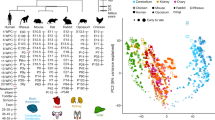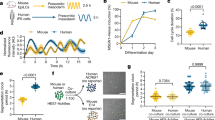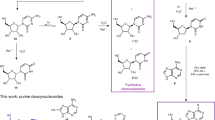Abstract
THE new forms of RNA synthesized during embryonic development of the South African clawed toad, Xenopus laevis, have come under investigation recently by Brown and Gurdon1 and are discussed more fully by Brown and Littna2. Since their work was concerned only with events in the embryo as a whole, we have undertaken a study of possible differences in the new forms of RNA synthesized in different tissue primordia of this species. In the preliminary work to be reported here, the nucleotide composition of the total acid-insoluble RNA extracted both from whole embryos and from ectoderm undergoing three different courses of differentiation—into neural plate, neural crest and epidermis—has been analysed. Although data published by Ycas3 indicated that different tissues of the adult rat do not show any significant differences in their RNA composition, there have been several other reports4–7 of altered base ratios in UNA of tissue cells undergoing special phases of modified protein synthesis in response to external stimuli. It seemed likely, therefore, that embryonic tissues responding to stimuli such as neural induction might also show some alterations of RNA base ratios. As will be reported here, RNA extracts both from whole embryos and from the isolated ectoderm do, in fact, exhibit some changes in base ratios, which are of general interest in view of the protein syntheses known to be occurring at these stages of development.
This is a preview of subscription content, access via your institution
Access options
Subscribe to this journal
Receive 51 print issues and online access
$199.00 per year
only $3.90 per issue
Buy this article
- Purchase on Springer Link
- Instant access to full article PDF
Prices may be subject to local taxes which are calculated during checkout
Similar content being viewed by others
References
Brown, D. D., and Gurdon, J. B., Proc. U.S. Nat. Acad. Sci., 51, 139 (1964).
Brown, D. D., and Littna, E., J. Mol. Biol., 8, 669 (1964).
Ycas, M., Int. Rev. Cytol., 13, 1 (1962).
Holland, J. J., Proc. U.S. Nat. Acad. Sci., 48, 2044 (1962).
Hyden, H., and Egyhazi, E., J. Cell Biol., 15, 37 (1962).
Mazurov, V. I., and Orekhovitch, V. N., Vopr. Med. Khimii, 9, 436 (1963).
Scholtissek, C., Biochem. Zeit., 332, 467 (1960).
Chen, P. S., Exp. Cell Research, 21, 523 (1960).
Schmidt, G., and Thannhauser, S. J., J. Biol. Chem., 161, 83 (1945).
Markham, R., in Methods of Plant Analysis, edit. by Peach and Tracey, 4 (Berlin, Springer Verlag, 1955).
Beaven, G. H., Holiday, E. R., and Johnson, E. A., in The Nucleic Acids, edit. by Chargaff and Davidson, 1, 439 (London, Academic Press, 1955).
Brachet, J., Denis, H., and de Vitry, F., Develop. Biol., 9, 398 (1964).
Denis, H., Develop. Biol., 9, 458 (1964).
Wilde, C. E., J. Morph., 97, 313 (1955).
Author information
Authors and Affiliations
Rights and permissions
About this article
Cite this article
DEUCHAR, E., BRISTOW, D. Changing Base Ratios in RNA of Developing Tissues of Xenopus laevis. Nature 205, 1321–1322 (1965). https://doi.org/10.1038/2051321a0
Issue Date:
DOI: https://doi.org/10.1038/2051321a0
This article is cited by
Comments
By submitting a comment you agree to abide by our Terms and Community Guidelines. If you find something abusive or that does not comply with our terms or guidelines please flag it as inappropriate.



